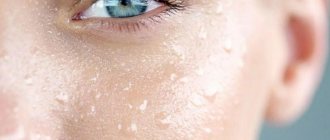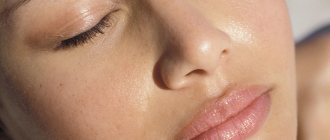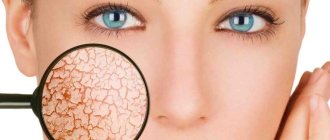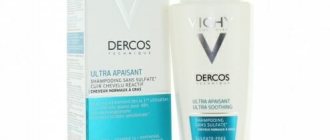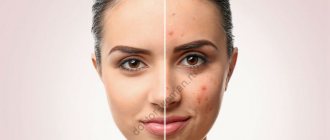The main cause of oily skin
The appearance of an oily sheen on the skin is associated with overproduction of sebum.
Testosterone stimulates the sebaceous glands. When hormonal surges occur, it is produced in larger quantities, which provokes an increased release of sebum.
The main physiological surges of hormones occur when:
- Puberty
- Pregnancy
- Taking oral contraceptives
- Menopause
However, outside of these conditions, an increase in sebum production may be a marker of changes in hormonal levels due to an endocrinological disease . Which will require a visit to an endocrinologist for consultation and assessment of hormonal levels.
Provoking factors for testosterone release are also:
- Stress, emotional disturbances, depressive states
- Professional sports
- Physical fatigue
Other causes of oily skin
The second reason is exposure to external factors that provoke dehydration, loss of necessary skin protection and, as a protective reaction, the release of sebum.
Functions of sebum:
- Epidermal protection
- Preventing Dehydration
- Skin thermoregulation
How to care for oily skin?
Before selecting care products, make sure you have correctly identified your skin type. If oily shine is noticeable only in the T-zone (on the forehead, nose and chin), then this is a combination type. In addition, only 10% of people still have oily, porous skin after age 35—the sebaceous glands can reduce sebum production by age 25 [2].
If you are sure that your skin type is correct, follow the appropriate care recommendations.
How to clean
It is recommended to cleanse oily facial skin 2 times a day. Apply foam or gel to damp skin using massaging movements (preferably with a sponge - it will better cleanse the pores). Do not use antibacterial or any alkaline soap for washing, otherwise you will dry out the epidermis and provoke increased sebum production. Rinse off with warm water, then rinse your face with cool water to tighten pores. After washing, wipe your face with toner or lotion with zinc oxide and salicylic acid.
Important! Do not wash your face with hot water - it increases the activity of the sebaceous glands.
For deep cleansing, use scrubs and peels with soft ingredients. One or two treatments per week are enough to remove dead cells and avoid clogged pores. If you use scrubs and peels more often, you can provoke increased oil secretion and thickening of the skin.
How and why to moisturize
The less moisture in the skin, the more active the sebaceous glands work. To moisturize, you can use a fluid cream or gel with a light texture (for example, “Instant Matte” aqua cream). These products usually contain hyaluronic acid, glycerin, collagen or aloe. Most creams for oily skin, in addition to moisturizing, also have a mattifying effect.
Important! In winter, apply moisturizer no later than an hour before going outside, otherwise your skin will become dehydrated. Use evening cream at any time of the year half an hour to an hour before bedtime.
For salon or home care, moisturizing masks for oily facial skin containing plant extracts, oils and antibacterial components are suitable.
Causes of increased oily skin
1. Prolonged exposure to the sun, climate change
Activation of the sebaceous glands is another protective mechanism of the skin, in addition to the formation of a tan, from the harmful effects of UV rays.
2. Illiterate care and performing aggressive procedures without further adequate skin care.
In this case, the release of sebum is a protective reaction to skin injury. If rich care products are not used, the skin itself forms a protective sebaceous film on its surface.
3. Disturbances in nutrition and gastrointestinal tract function
Spicy, salty foods and alcohol activate the sebaceous glands. A number of studies have shown a high correlation between milk consumption and the appearance of oily shine and acne on the face.
Greasy hair
Fungus
Gastritis
HIV
11722 17 February
IMPORTANT!
The information in this section cannot be used for self-diagnosis and self-treatment.
In case of pain or other exacerbation of the disease, diagnostic tests should be prescribed only by the attending physician. To make a diagnosis and properly prescribe treatment, you should contact your doctor. Oily hair: causes of appearance, what diseases cause it, diagnosis and treatment methods.
Definition
Oily or greasy hair becomes when the sebaceous glands located on the scalp produce excess sebum (fat). This condition is called oily seborrhea. In addition to oily hair, a person may be bothered by flaking, itching, hair loss, redness and burning of the affected areas of the skin. In rare cases, a bacterial infection may occur and a fungal infection of the skin may develop.
Types of oily seborrhea
Dermatologists and trichologists (specialists involved in the treatment of hair and scalp) identify several options for the course of oily seborrhea:
- liquid oily seborrhea, which is characterized by the fact that the hair always looks greasy and acquires a specific oily shade, the pores look enlarged;
- thick oily seborrhea, which is characterized by excessive hair loss and excessive rigidity, dandruff, acne.
Possible causes of oily hair
Doctors say that the most significant cause of oily seborrhea is hormonal imbalances in the body, caused by both pathological processes and the use of hormonal medications.
In addition, hair can become oily as a result of chronic stress, improper care of the scalp, taking certain medications (for example, interferons, lithium preparations), vitamin C deficiency, which leads to a decrease in the protective properties of the skin, and excessive sun exposure.
Diseases that lead to oily hair
- Itsenko-Cushing's disease is a disease associated with an imbalance of female and male hormones, caused by the formation of a benign brain tumor. Symptoms include high blood pressure, weight gain, hyperhidrosis, and oily hair.
- Thyroid diseases.
- Diseases of the genitourinary system of an infectious, bacterial or traumatic nature.
- Parkinson's disease.
- Vitamin deficiencies.
- Autoimmune diseases, such as psoriasis.
- Epilepsy.
- Pathologies of the gastrointestinal tract. For example, an infection Helicobacter pylori
is one of the main causes of gastritis, as well as peptic ulcers of the stomach and duodenum. The disease provokes and enhances the formation of toxic substances that affect the condition of the skin.
- Marked decrease in immunity (in particular, with HIV infection).
- Atopic dermatitis is a multifactorial inflammatory skin disease characterized by a chronic course with regular exacerbations.
- Rosacea is manifested by redness of the skin and the formation of nodules that may contain pus.
Which doctors should I contact?
Dermatologists and trichologists deal with skin and hair problems. Since the problem of oily hair is not isolated, but requires an integrated approach, to find and eliminate the causes of malfunction of other body systems, you may need the recommendations of a gastroenterologist if the problem of oily hair is caused by a gastrointestinal disease. If there is excess weight that cannot be eliminated by normal dietary restrictions, accompanied by hypertension and an increase in glucose (sugar) levels in the blood, a consultation is recommended. One of the reasons for the appearance of oily hair is the presence of depression, nervousness, and mood swings - in this case, a visit to a psychotherapist is advisable. More specific therapy includes consultations with a neurologist, neurosurgeon, infectious disease specialist, etc.
Diagnosis and examinations for oily seborrhea
To compile a complete clinical picture, the doctor collects anamnesis to establish or suspect the pathology that led to oily seborrhea, and carefully examines the scalp. Diagnostic tests include:
- taking a piece of skin for microscopic examination and establishing specific signs of seborrhea, as well as culture for fungi;
How to prevent oily skin
Carefully re-read the main and probable causes of increased oily skin. If necessary, consult a specialist (general practitioner, endocrinologist or gastroenterologist).
Independent steps to correct oily skin:
Don't sunbathe!
Exposure to direct sunlight activates the sebaceous glands, because... the skin is protected from their aggressive effects.
UV rays have a temporary bactericidal effect, and subsequently a sharp relapse of the rash. Even if you were not previously prone to rashes, UV rays lead to a decrease in local immunity and activation of opportunistic microflora, which can trigger the appearance of acne.
Regular application of day cream with mineral protection factor
It is imperative to use a cream with SPF, the main thing is that the protection factor is physical and not chemical.
Chemical photo filters convert the energy of UV rays into heat, which has a detrimental effect on the functioning of the sebaceous glands.
Physical photo filters simply reflect UV rays without causing an increase in skin greasiness.
Tone cream SPF30 with zinc for the face DermaQuest - for those who do not like pale skin color. A cream based on micronized zinc oxide 18.6%, which contains pigments that give the skin a light tan.
Do not overdry the skin!
The use of aggressive cosmetics and procedures increases the risk of dehydration, which means a response from the sebaceous glands in the form of hyperproduction of sebum.
Daily use of cleansers with high percentages of acids, peelings with AHAs that activate the sebaceous glands, tonics with alcohol are enemies for skin with increased sebum production.
Use specialized toners for oily skin:
- Complete the cleansing process
- Restores skin pH – reduces the risk of new sebum production
- They have a sebum-regulating and at the same time moisturizing effect (which is also necessary - see the next point).
Spray serum for oily and problem skin “White willow and juniper” Circadia for daily care of oily skin with a serum effect. Regulates the functioning of the sebaceous glands, makes the skin matte, has a moisturizing and regenerating effect on the skin.
Teenagers can use the product as a moisturizing serum.
Regular skin moisturizing
Moisturizers are needed to avoid skin dehydration and compensatory release of sebum. Use moisturizers based on hydrants (substances that attract water), such as hyaluronic acid.
Serum B5 moisturizing mattifying for oily skin DermaQuest is a unique gel serum designed specifically for skin with an oily sheen. Micronized hyaluronic acid moisturizes and restores the skin, while Lilac Stem Cells and sebum regulators normalize sebum production.
The result is instantly hydrated and matte skin!
Cosmetological methods for treating oily facial skin
Today, oily facial skin can be treated quite effectively using various professional methods, including:
- Deep cleansing of the skin with removal of comedones;
- Darsonvalization (pulsed electric current on inflamed areas);
- Vaporization with a steam apparatus to soften and clean the skin;
- Massotherapy;
- Cryotherapy with liquid nitrogen to tighten pores;
- Removing sebaceous plugs.
All these methods of combating oily skin on the face are known to the cosmetologists of the ImageLab center, and are quite successfully used in practice. At the same time, our specialists will not only help you get rid of the problem, but will also give practical advice on how to avoid encountering such a problem in the future.
Fat forehead causes in women, what to do. Oily skin on the forehead: what to do?
The epidermis on the forehead tends to become most oily during adolescence.
Closer to middle age, less subcutaneous fat is produced, and by old age, fat ceases to be produced completely. The main signs of a fat forehead are:
- Shine;
- Subcutaneous tubercles;
- Lots of blackheads;
- Wide pores.
It is necessary to get rid of fat on the forehead both from the outside and from the inside. As for external procedures, these are standard facial care procedures:
- Wash your face with warm water twice a day. The use of hot water is not recommended, since high temperatures further stimulate the sebaceous glands;
- Do not use aggressive care products. Choose a suitable washing gel;
- It is necessary to exfoliate weekly;
- Masks can be made no more than twice a week. White clay, lemon juice or potatoes ground in a meat grinder work well;
- Try to use foundation less often;
- Once a week, you can wipe your forehead with a solution of a teaspoon of sea salt in half a liter of melt water.
As a comprehensive approach to getting rid of fat on your forehead, review your diet:
- Avoid fatty and fried foods;
- Eliminate salty and sweet foods;
- Try to eat natural foods;
- Add vitamin B6 to your diet; it is found in fish, pork, beef, bananas, avocados, nuts, beans and liver;
- It is also advisable to eat foods rich in vitamin B2: potatoes, oatmeal, milk, cocoa, lamb.
